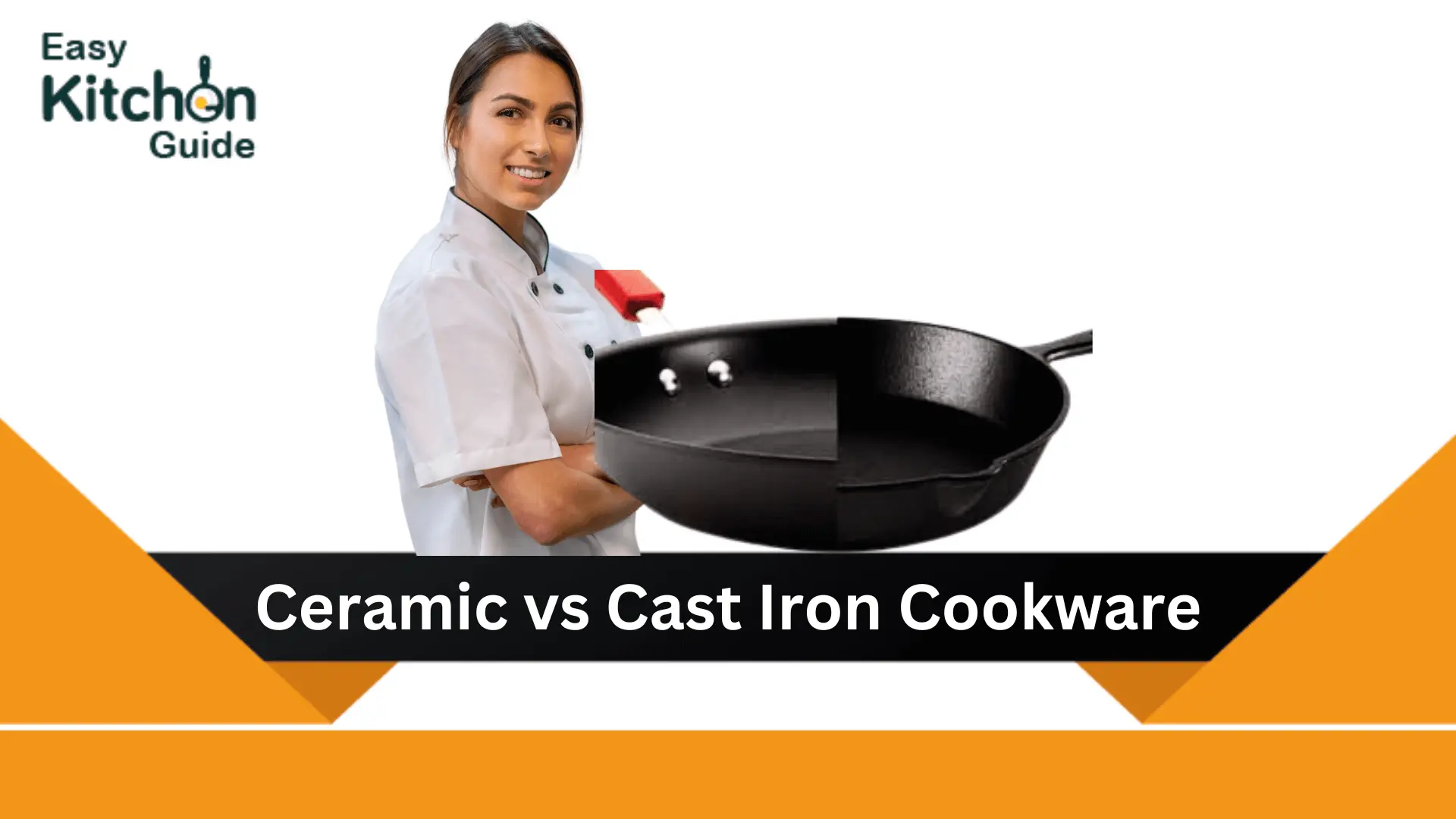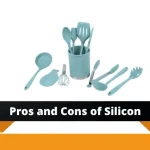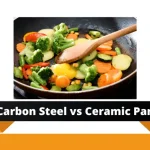Choosing between ceramic and cast iron has been a longstanding debate among home cooks and professional chefs in the bustling world of cookware. Each material brings its own qualities to the kitchen, and making the right choice depends on various factors. In this comprehensive guide, we’ll explore the key differences, advantages, and best uses for ceramic and cast iron cookware, helping you make an informed decision for your culinary adventures.
What are the key differences between ceramic and cast iron cookware?
Table of Contents,
Ceramic Coating vs. Seasoned Cast Iron
Ceramic cookware typically features a non-stick coating from materials like silicon or PTFE (polytetrafluoroethylene). This coating provides an excellent non-stick surface, making cooking easy with minimal oil and ensuring easy cleanup. On the other hand, cast iron cookware gains its non-stick properties through seasoning—applying and baking layers of oil onto the surface, creating a natural non-stick coating over time.
Comparison of Durability and Maintenance
When it comes to durability, both ceramic and cast iron cookware are robust options. However, ceramic cookware may be prone to chipping if not handled carefully, while cast iron is known for its exceptional longevity. Cast iron cookware requires regular seasoning to maintain its non-stick properties and prevent rust, whereas ceramic cookware demands delicate handling to avoid wear and tear on its coating.
Heat Conductivity and Temperature Versatility
Cast iron is excellent for heat retention and even heat distribution. Once heated, it stays hot for a long time, making it ideal for slow cooking and baking. While proficient in heat retention, ceramic cookware may not distribute heat as evenly as cast iron. It’s crucial to adjust cooking techniques accordingly when using ceramic for different recipes.
Non-stick Properties and Scratch Resistance
Ceramic cookware shines in the non-stick department, allowing easy food release and quick cleaning. However, it may not be as scratch-resistant as cast iron. Once properly seasoned, cast iron develops a naturally non-stick surface that can withstand metal utensils.
Types of Food Best Suited for Each Cookware
The type of food you love to prepare plays a significant role in choosing between ceramic and cast iron. Ceramic cookware is excellent for dishes that require precise temperature control and gentle cooking, such as omelets, pancakes, and delicate sauces. On the other hand, cast iron excels in dishes that benefit from slow cooking, searing, and braising, like stews, roasts, and cornbread.
Benefits and drawbacks of ceramic cookware:
Advantages and Limitations of Using Cast Iron
Ceramic cookware boasts several advantages, including its non-stick properties, ease of cleaning, and aesthetic appeal. It’s also generally lighter than cast iron, making it more manageable for daily use. However, ceramic cookware may not withstand high temperatures as well as cast iron, and its coating can wear over time, affecting its non-stick performance.
Addressing High Heat and Searing Capabilities
Cast iron’s ability to withstand high temperatures and evenly distribute heat makes it the go-to choice for searing steaks and achieving a perfect crust on cornbread. The material’s superior heat retention allows for a seamless transition from stovetop to oven, making it versatile for various cooking techniques. While ceramic cookware can handle moderate heat, it may not be the best option for high-temperature cooking or searing.
Comparison of Weight and Handling
One of the notable differences between ceramic and cast iron is their weight. Ceramic cookware is generally lighter, providing ease of handling and maneuverability, especially for those with physical limitations. Cast iron, on the other hand, is substantial and may require a bit more effort to lift and maneuver. The weight difference can be a crucial factor for those who value convenience in the kitchen.
Environmental Considerations and Sustainability
In the quest for sustainable living, considering the environmental impact of cookware is essential. Ceramic cookware can be a more sustainable option when made with eco-friendly materials. Cast iron, a durable material that can be passed down through generations, also aligns with sustainability goals. However, producing both materials involves energy-intensive processes, so longevity and responsible disposal should be considered.
Here is a quick Summary of the Comparison.
| Feature | Ceramic Cookware | Cast Iron Cookware |
|---|---|---|
| Coating | Non-stick coating (silicon or PTFE) | Seasoned surface |
| Durability | Moderately durable, prone to chipping | Highly durable, can last for generations |
| Maintenance | Easy to clean, dishwasher-safe | Requires regular seasoning to maintain non-stick properties and prevent rust |
| Heat conductivity | Good heat conductivity, but not as even as cast iron | Excellent heat conductivity and heat retention |
| Temperature versatility | Suitable for moderate temperatures, not ideal for high heat | Withstands high temperatures, suitable for searing and baking |
| Non-stick properties | Excellent non-stick properties | Develops a natural non-stick surface over time |
| Scratch resistance | Not as scratch-resistant as cast iron | Can withstand metal utensils |
Top Ceramic and Cast iron Cookware to Buy
Based on My own Intense research and use i have summarized a few must-buy products for you in both categories.
Ceramic cookware:
- GreenPan Rio Healthy Ceramic Nonstick 16-piece cookware
- Ninja CW99009 Extended Life Premium Ceramic Cookware Set
Cast iron cookware: - Lodge 10.25 Inch Cast Iron Pre-Seasoned Skillet
- Nuwave Healthy Duralon Blue Ceramic Nonstick Cookware Set
Best uses for ceramic pots and pans.
Optimal Performance of Cast Iron Skillets and Pans
Cast iron truly shines in specific cooking scenarios. The even heat distribution and retention make it perfect for slow-cooked dishes like stews and roasts. The versatile nature of cast iron allows it to go seamlessly from the stovetop to the oven, making it an excellent choice for dishes that require both.
Cooking Acidic Foods in Ceramic and Cast Iron
Ceramic cookware is an excellent option for dishes that involve acidic ingredients, such as tomatoes or citrus fruits. The non-reactive nature of ceramic prevents any metallic taste from leaching into the food. On the other hand, cast iron, if well-seasoned, can handle acidic foods, but prolonged contact may affect the seasoning and introduce a metallic taste. Regular maintenance and seasoning can mitigate this.
Choosing the Right Cookware for Baking and Roasting
When baking and roasting, cast iron excels in creating a crispy crust on bread or achieving the perfect golden-brown finish on a roast. Its ability to evenly distribute heat ensures the entire dish is perfectly cooked. Its precise temperature control makes ceramic cookware well-suited for delicate baking tasks like soufflés or custards.
Longevity and Impact on Food Flavor
Both ceramic and cast iron cookware have the potential for longevity when properly cared for. With its seasoned surface, cast iron can last for generations, becoming a cherished family heirloom. Ceramic cookware, while durable, may experience wear on its coating over time. Proper care and handling are crucial for maintaining the longevity of both types of cookware. The impact on food flavor also varies, with well-seasoned cast iron enhancing the taste of certain dishes.
Also, Read Trending Topics
- Carbon Steel vs Ceramic Pan
- Copper vs Aluminum Cookware
- Best Electric Skillet For Frying Chicken in 2024
Maintenance and Care Requirements for Ceramic and Cast Iron Cookware
Cleaning and Dishwasher Compatibility
Ceramic cookware often boasts easy cleanup, with food easily sliding off its non-stick surface. Most ceramic cookware is dishwasher-safe, providing convenience for those with busy lifestyles. On the other hand, cast iron requires more attention when cleaning. While soap should be avoided, cleaning with hot water and a stiff brush is usually sufficient. Dishwasher use for cast iron is generally discouraged, as it may strip away the seasoning.
Seasoning and Re-seasoning Cast Iron
The unique aspect of cast iron maintenance is the seasoning process. Regularly seasoning your cast iron cookware helps maintain its non-stick properties, prevents rusting, and adds layers of flavor to your dishes over time. It’s a basic but important step in the cleaning process that requires a thin layer of oil applied onto the surface before storing.
Ceramic Coatings and Potential Wear Over Time
Ceramic cookware maintenance is relatively straightforward. While the non-stick coating simplifies cleaning, it may wear over time, especially with metal utensils. To extend the life of ceramic cookware, use utensils with a softer material and avoid high heat when not necessary.
Storage and Rust Prevention for Cast Iron
Proper storage is essential for both ceramic and cast iron cookware. Store cast iron in a dry place to prevent rusting. Applying a thin layer of oil after each use helps create a protective barrier against moisture. Ceramic cookware, while not prone to rust. Store them with care to prevent chipping. Stack cookware with protective layers or use soft dividers to maintain the integrity of the ceramic coating.
Handling and Avoiding Chipping in Ceramic Cookware
Ceramic cookware requires gentle handling to prevent chipping or scratching of its coating. Using silicone or wooden utensils is advisable, as metal utensils can damage the ceramic surface. Additionally, avoid drastic temperature changes, such as placing hot cookware on a cold surface, to prevent thermal shock and potential cracking.
Which Cookware – Ceramic or Cast Iron – Works Best for Different Cooking Methods?
Comparison of Searing, Frying, and Sautéing
When it comes to searing, cast iron takes the spotlight. Its ability to evenly distribute and retain heat makes it the perfect choice for achieving a crispy crust on steaks or caramelizing onions. Frying, too, is well-suited to cast iron, as it maintains a consistent temperature throughout the cooking process. Sautéing, with its quick and high-heat demands, aligns with the capabilities of cast iron and ceramic. However, the choice may depend on personal preference, with ceramic offering precise temperature control and cast iron providing even heat distribution.
Slow Cooking and Braising in Ceramic and Cast Iron
Slow cooking and braising are where cast iron truly excels. The material’s ability to maintain a consistent and low heat over an extended period makes it perfect for dishes like stews, chili, or braised meats. Ceramic cookware, while capable of slow cooking, may not retain heat as efficiently as cast iron. It’s essential to monitor temperature settings to achieve the desired results.
Boiling and Simmering in Each Type of Cookware
Boiling and simmering are tasks that both ceramic and cast iron can handle. Ceramic cookware’s precise temperature control is advantageous for delicate tasks like simmering sauces or boiling pasta. With its excellent heat retention, cast iron can quickly bring water to a boil and maintain a simmer with less energy input.
Handling High Temperatures with Ceramic and Cast Iron
When it comes to high-temperature cooking, cast iron emerges as the winner. Its ability to withstand and evenly distribute high heat makes it ideal for searing, frying, and achieving a perfect crust on certain dishes. While ceramic cookware can handle moderate to high heat, it may not be as efficient as cast iron in tasks that demand extreme temperatures.
Adapting to Different Heat Sources and Environments
Both ceramic and cast iron cookware are adaptable to various heat sources, including gas, electric, and induction stovetops. Cast iron’s versatility extends to open flames and oven use, making it a reliable choice for outdoor cooking. Ceramic cookware may have limitations with open flames, and it’s crucial to check the manufacturer’s guidelines for specific heat source compatibility.
In Summary:
There is no one-size-fits-all answer to the endless debate of ceramic vs. cast iron cookware. Choosing these materials depends on your cooking style, preferences, and the dishes you love preparing. Ceramic cookware offers a non-stick surface, precise temperature control, and lighter weight, while cast iron provides unparalleled durability, excellent heat retention, and versatility in various cooking methods.
Consider the nuances of each material, weigh the pros and cons, and let your cooking preferences guide your decision. Whether you opt for the sleek elegance of ceramic or the timeless strength of cast iron, both have a place in the kitchen, contributing to the joy and satisfaction of preparing delicious meals for yourself and your loved ones. So, the next time you stand before the cookware aisle, armed with the knowledge of ceramic vs. cast iron, choose the one that suits your culinary journey the best.
With these insights, you’re well-equipped to make an informed decision and elevate your cooking experience with the perfect cookware for your kitchen. After all, the heart of any delectable dish lies in the ingredients and the vessel that brings them to life.







